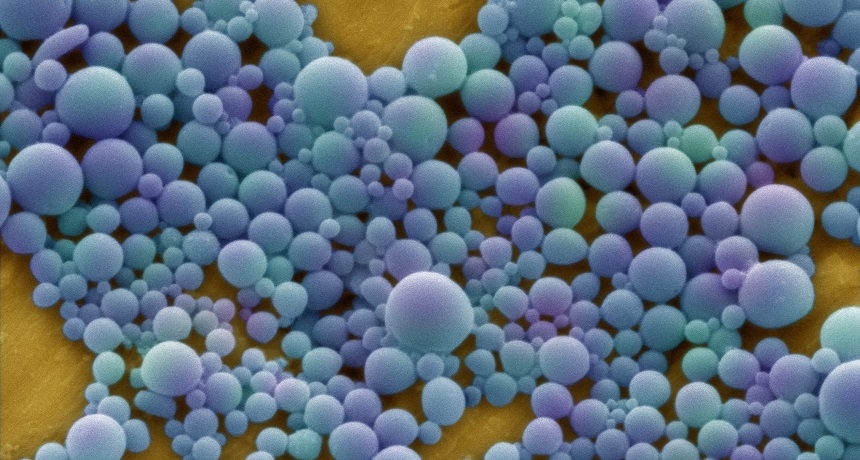Injected nanoparticles treat internal wounds
New particles can stop bleeding and inflammation in the lungs of someone injured in an explosion

This scanning electron micrograph shows specially engineered nanoparticles that are used to deliver drugs into tissues. If designed with a special surface coating, such drug carriers can home in on particular cells to help stop bleeding and heal injuries.
Annie Cavanagh/Wellcome Images
Ka-boom! An exploding bomb knocks a soldier to the ground. From the outside, she doesn’t look hurt. But when the shock wave from the blast tore through her body, it left her fragile lungs bleeding. She needs quick treatment to survive. One day, though, an injection of tiny, wound-seeking particles might save the life of troops injured like this in combat.
The microscopic tools are called nanoparticles. Each round particle is about 500 nanometers — that’s just 500 billionths of a meter — across. Researchers are working to create versions of these particles to start healing wounds before a patient even reaches the hospital.
“One cool thing about a nanoparticle is you can design it to actually seek out its target,” says Pamela VandeVord. She’s a biomedical engineer at Virginia Tech in Blacksburg. VandeVord works with Erin Lavik at Case Western Reserve University in Cleveland, Ohio. Together, they are creating and testing nanoparticles to treat blast injuries deep inside the body.
The particles team up with cells called platelets to hunt down the injury. Wherever a person is bleeding, platelets are hard at work trying to build clots to stop the loss of blood. The outsides of the nanoparticles carry special molecules. Those exterior chemicals fit into active platelets like a key into a lock. The nanoparticles travel in search of injuries until they encounter a lock. Then they latch onto platelets. Once that happens, the nanoparticles boost the platelets’ ability to make blood clots.
But that’s not the end of it. The nanoparticles also carry a medicine. The outer shell of the particles breaks down quickly in the body. As it dissolves, it releases its drug, called dexamethasone (DEX-uh-METH-ah-soan). That medicine fights inflammation.
“If there’s too much inflammation, that can lead to cell death” and more damage, VandeVord explains. Doctors normally use this drug to treat illnesses like arthritis and allergies. But VandeVord uses it to protect lung cells from the inflammation caused by a blast injury.
VandeVord didn’t have any injured soldiers in her lab. Rats served as her stand-ins. She treated them with a drug to temporarily deaden their nerves. Then she used a specially designed chamber to send a shock wave through each rat. Its body responded as if it had been rocked by a nearby explosion. Afterward, VandeVord injected some of the animals with the drug-carrying particles.
The treatment helped the rats’ lungs work better soon after the injury. One week later, these rats also had less damage to their lungs than untreated animals did. The scientists shared their results online March 23 in ACS Macro Letters.
It’s important to have treatment for internal injuries, as in the lungs, VandeVord says. After all, she notes, “If your lungs stop working, you’re not going to survive.”
“This is a real step forward,” says Justin Hanes, who was not involved in the research. He works at the Johns Hopkins University School of Medicine in Baltimore, Md. There he, too, studies nanoparticles that deliver medicines. The Virginia Tech researchers, he notes, “seem to be getting real improvements from just a single dose” of nanoparticles.
VandeVord hopes that drug-releasing nanoparticles one day may treat many types of injuries. An injection might slow down bleeding in a car-crash victim, for example. For soldiers hit by an explosion, the treatment might keep troops alive long enough to reach a hospital.
Power Words
(for more about Power Words, click here)
allergy The inappropriate reaction by the body’s immune system to a normally harmless substance. Untreated, a particularly severe reaction can lead to death.
arthritis A disease that causes painful inflammation in the joints.
biomedical engineer An expert who uses science and math to find solutions to problems in biology and medicine; for example, they might create medical devices such as artificial knees.
clot (in medicine) A collection of blood cells (platelets) and chemicals that collect in a small region, stopping the flow of blood.
inflammation The body’s response to cellular injury and obesity; it often involves swelling, redness, heat and pain. It is also an underlying feature responsible for the development and aggravation of many diseases, especially heart disease and diabetes.
molecule An electrically neutral group of atoms that represents the smallest possible amount of a chemical compound. Molecules can be made of single types of atoms or of different types. For example, the oxygen in the air is made of two oxygen atoms (O2), but water is made of two hydrogen atoms and one oxygen atom (H2O).
nano A prefix indicating a billionth. In the metric system of measurements, it’s often used as an abbreviation to refer to objects that are a billionth of a meter long or in diameter.
nanoparticle A small particle with dimensions measured in billionths of a meter.
particle A minute amount of something.
platelets The smallest of blood cells, their role is to search for signs that a vessel has been damaged. Then they congregate at the site of damage and transform themselves, growing long tentacles. There they link together, creating a clot to plug any hole — stemming the potential loss of blood.







